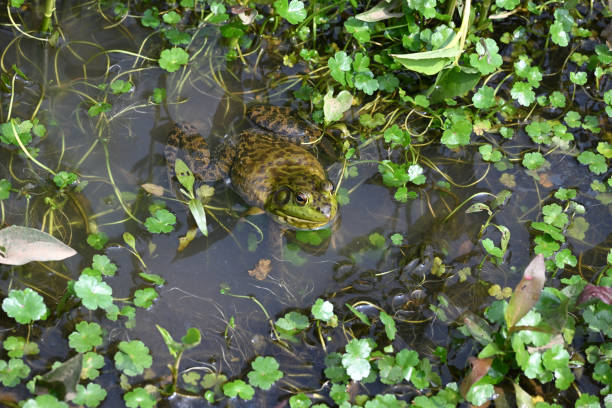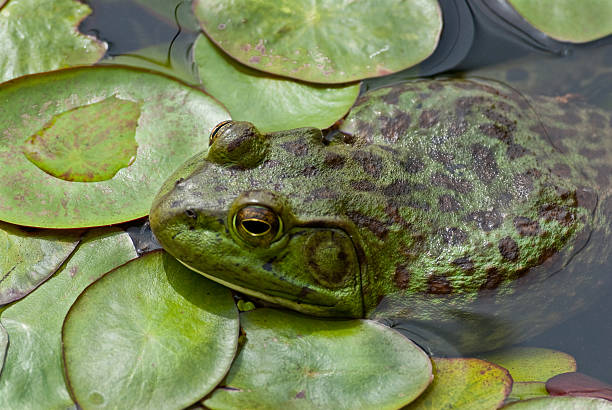Table of Contents
Scientific Classification
| Kingdom | Animalia |
| Phylum | Chordata |
| Class | Amphibia |
| Order | Anura |
| Family | Ranidae |
| Genus | Lithobates |
| Species | Lithobates catesbeianus |
| Scientific Name | Lithobates catesbeianus |
Description
The American Bullfrog (Lithobates catesbeianus) is the largest frog found in North America. Known for their deep, resonant calls, these amphibians can be heard echoing across ponds and lakes during the warmer months. They possess a sturdy body covered in smooth skin that ranges from green to brown, often featuring darker spots. Their underbelly is usually pale or yellowish. With powerful hind legs, they can leap great distances, which helps them evade danger.
One of the most distinctive characteristics of the American Bullfrog is its large, round eardrums, known as tympanic membranes, located just behind the eyes. These membranes are sensitive to sound vibrations, allowing the frogs to quickly respond to predators or potential mates. Typically, males are smaller than females, but they have larger tympanic membranes and a more prominent yellow throat.
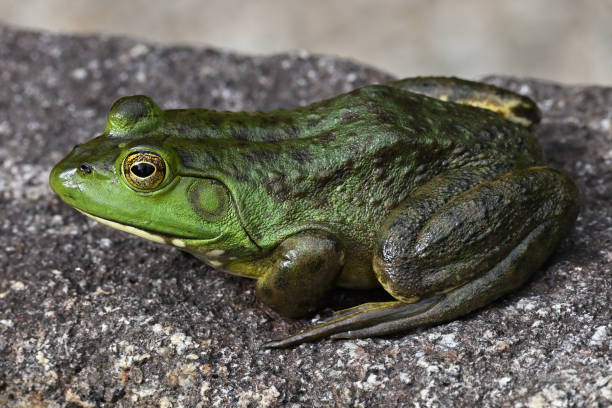
Distribution
The American Bullfrog is found throughout North America. Its ability to adapt and its aggressive behavior contribute to its status as an invasive species in various regions. It often outcompetes native amphibians for both food and living space.
Habitat
Bullfrogs are primarily aquatic creatures that favor calm or slow-moving freshwater habitats. They can be found in ponds, lakes, swamps, marshes, and sluggish streams that have plenty of vegetation. Warm, shallow waters are essential for their breeding. Additionally, they require numerous hiding spots to evade predators. These frogs are adaptable and can thrive in a range of aquatic environments, including both natural and artificial bodies of water such as reservoirs and farm ponds.
Diet
The American Bullfrog is a fierce predator with a varied diet. They will eat almost anything that fits into their large mouths, such as:
- Insects (like beetles, grasshoppers, and flies)
- Small fish
- Other amphibians (including smaller bullfrogs)
- Crustaceans
- Birds
- Small mammals (such as mice)
They employ a sit-and-wait strategy for hunting, remaining still at the water’s edge until prey comes within reach. Their strong, sticky tongue swiftly snatches up unsuspecting victims.
Behavior
Bullfrogs are primarily active when the weather is warm. As temperatures rise, they become more active during the night. Their remarkable camouflage allows them to blend into their environment, helping them evade predators. During the breeding season, males often use their distinctive “jug-o-rum” call to establish their territories and attract potential mates.
Additionally, they are recognized for their aggressive behavior. Males are territorial and will protect their breeding areas from other males. They often engage in vocal duels and physical confrontations to establish dominance.
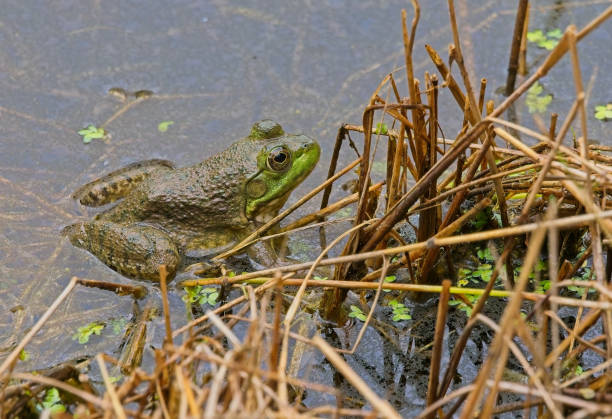
Lifespan
American Bullfrogs usually live for 7 to 9 years in the wild. However, some can reach 10 years or more. In captivity, with ideal care, they can live up to 16 years.
Reproduction and Lifecycle
The breeding season typically takes place from late spring to summer, varying with the local climate. Males call out loudly to attract females and to defend their territory against other males.
Reproductive Process:
Mating Call: Males emit deep, resonant croaks to draw in females.
External Fertilization: Females deposit thousands of eggs in shallow water, which males then fertilize externally.
Tadpole Stage: The eggs hatch into tadpoles within a few days. These tadpoles live in water and undergo changes over a period of 1 to 3 years, depending on their environment.
Adult Stage: Tadpoles develop lungs, lose their tails, and transform into young frogs.
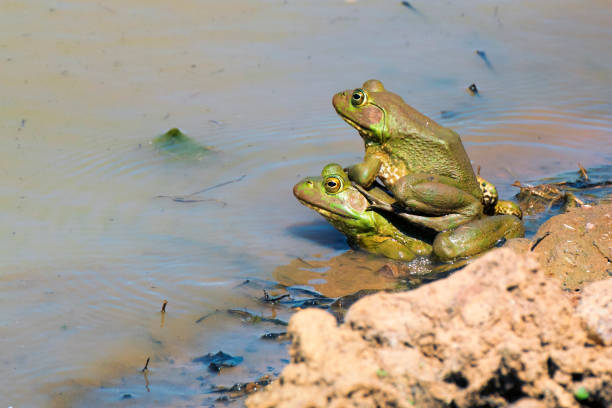
Predators
Despite their size, American Bullfrogs have numerous natural predators, including:
Birds (herons, hawks, and kingfishers)
Snakes
Raccoons
Large fish
Humans (harvesting for food and pets)
Tadpoles are very vulnerable. They often become food for aquatic insects, fish, and other amphibians.
Adaptations
The American Bullfrog has several adaptations that aid in its survival:
Strong Hind Legs: Their powerful legs enable them to jump great distances, allowing them to evade predators more effectively.
Camouflage: The mottled pattern of their skin allows them to blend in with the surrounding aquatic plants.
Big Mouth & Broad Diet: They have the ability to consume a wide variety of prey, which helps them thrive in diverse environments.
Loud Vocalization: Their deep calls serve to establish territory and attract potential mates.
Hibernation: In colder regions, bullfrogs burrow into the mud at the bottom of ponds, entering a state of dormancy during the winter months.
Conservation Status
The IUCN (International Union for Conservation of Nature) classifies the American Bullfrog as “Least Concern,” indicating that they are not currently at significant risk of extinction. However, in regions where they have been introduced, they can become invasive, resulting in a decline in native amphibian populations. Conservation initiatives in these areas focus on managing bullfrog populations to help maintain ecological balance.
Conclusion
The American Bullfrog is an intriguing amphibian. It’s recognized for its loud calls, large appetite, and territorial nature. These frogs play an important role in their native ecosystems. However, when they are introduced to new regions, they can create problems. Their ability to thrive in various environments demonstrates their resilience, making them one of the most successful amphibians in North America.
